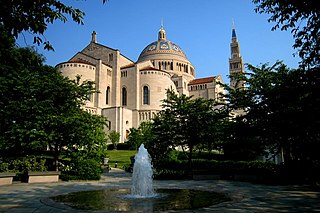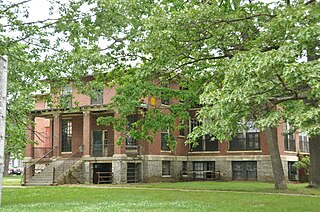
Hanover is a town in Plymouth County, Massachusetts, United States. The population was 14,833 at the 2020 census.

Maginnis & Walsh was an Boston-based architecture firm started by Charles Donagh Maginnis and Timothy Francis Walsh in 1905. It was known for its innovative design of churches in Boston in the first half of the 20th century.

Marycrest College Historic District is located on a bluff overlooking the West End of Davenport, Iowa, United States. The district encompasses the campus of Marycrest College, which was a small, private collegiate institution. The school became Teikyo Marycrest University and finally Marycrest International University after affiliating with a Japanese educational consortium during the 1990s. The school closed in 2002 because of financial shortcomings. The campus has been listed on the Davenport Register of Historic Properties and on the National Register of Historic Places since 2004. At the time of its nomination, the historic district consisted of 13 resources, including six contributing buildings and five non-contributing buildings. Two of the buildings were already individually listed on the National Register.

Richard James Cushing was an American prelate of the Catholic Church. He served as Archbishop of Boston from 1944 to 1970 and was made a cardinal in 1958. Cushing's main role was as fundraiser and builder of new churches, schools, and institutions. Unlike his predecessor, he was on good terms with practically the entire Boston elite, as he softened the traditional confrontation between the Catholic Irish and the Protestant upper-class. He built useful relationships with Jews, Protestants, and institutions outside the usual Catholic community. He helped presidential candidate John F. Kennedy deflect fears of papal interference in American government if a Catholic became president.

Taunton State Hospital is a psychiatric hospital located on Hodges Avenue in Taunton, Massachusetts. Established in 1854, it was originally known as the State Lunatic Hospital at Taunton. It was the second state asylum in Massachusetts. Most of the original part of the facility was built in a unique and rare neo-classical style designed by architects Boyden & Ball. It is also a Kirkbride Plan hospital and is located on a large 154-acre (62 ha) farm along the Mill River.
The Sisters of St. Francis of Assisi is a Catholic religious congregation for women founded in 1849. The motherhouse is in St. Francis, Wisconsin, in the Archdiocese of Milwaukee.

Portiuncula, also spelled Porziuncola or Porzioncula, is a small Catholic church located within the Papal Basilica of Saint Mary of the Angels in Assisi in the frazione of Santa Maria degli Angeli, situated about 4 kilometres (2.5 mi) from Assisi, Umbria. It is the place from where the Franciscan movement started.

The Immaculata Seminary Historic District, commonly known as Tenley Campus, is an 8.2-acre (3.3 ha) parcel of land, located off of Tenley Circle in the Northwest Washington, D.C. neighborhood of Tenleytown. The site of Dunblane, an early to mid-nineteenth-century Federal/Greek Revival-style manor house, it was once part of a large country estate on the outskirts of the capital city, owned by a succession of prominent Georgetown residents. From 1904 to 1906, the land was acquired by the Catholic Sisters of Providence of Saint Mary-of-the-Woods, who, for decades, operated all-girls primary, secondary, and postsecondary schools there under the Immaculata name, before being forced to shutter due to financial issues. Since 1986, it has been a satellite campus of American University, which purchased the site in part because of its proximity to Tenleytown station on the Red Line of the Washington Metro. It currently houses the school's Washington College of Law.
Founded in 1969, ARC/Architectural Resources Cambridge, Inc. is a national architectural design firm, located in Boston, Massachusetts, that specializes in Science/R&D, biotechnology, educational, athletic and corporate facilities. With an emphasis on innovative and sustainable design, ARC has garnered more than 70 awards from a wide range of professional organizations and publications.

St. Stephen's Church is a historic church in the North End of Boston, Massachusetts. It was built in 1802–1804 as the New North Church or New North Meeting House and was designed by the noted architect Charles Bulfinch. It is the only one of the five churches he designed in Boston to remain extant. The church replaced one which had been built on the site in 1714 and enlarged in 1730. The Congregationalist church became Unitarian in 1813, and the church was sold to the Roman Catholic Diocese in 1862, and renamed St. Stephen's. It was restored and renovated in 1964-65 by Chester F. Wright, and was added to the National Register of Historic Places in 1975.
This is an incomplete list of historic properties and districts at United States colleges and universities that are listed on the National Register of Historic Places (NRHP). This includes National Historic Landmarks (NHLs) and other National Register of Historic Places listings. It includes listings at current and former educational institutions.

The East Cambridge Historic District encompasses the historic center of East Cambridge, Massachusetts. It includes the major buildings that were built to house county services for Middlesex County beginning in the 1810s, and a cluster of largely vernacular Greek Revival worker housing located west of the county complex on Otis, Thorndike, Spring, and Sciarappa Streets. The district was listed on the National Register of Historic Places in 1983.

The Wrentham Developmental Center, formerly Wrentham State School, is a historic state-run medical facility for the treatment of psychiatric and developmental disorders. It is located on a large campus at the junction of Emerald and North Streets in Wrentham, Massachusetts. The school was authorized by the state in 1906, and the first phase of the campus was developed between 1909 and 1917. The school opened in 1910. The school had a typical patient population of 1,200-1,300 during the 1920s. The name was changed in the 1990s. The school campus was added to the National Register of Historic Places in 1994.

St. Charles Borromeo Church is a former parish of the Catholic Church in Waltham, Massachusetts. It is noted for its historic church building, completed in 1922. A high quality example of Italian Renaissance Revival architecture, it is emblematic of the shift on Waltham's south side from a predominantly Protestant population to one of greater diversity. The building was listed on the National Register of Historic Places in 1989.

The Lancaster Industrial School for Girls was a reform school on Old Common Road in Lancaster, Massachusetts. It was the country's first state reform school for girls, opening on August 26, 1856. The facility provided its charges with separate rooms, arranged in three-story cottages with kitchen, dining, and other public facilities on the ground floor, rooms for the girls and a housemother on the second, and space for teachers on the third floor. This school paved the way of social reform, moving away from child imprisonment towards a correctional paradigm. This was in part achieved because of the observed benefits of environmental change in children, as well as the importance of education plus the added pressures of having to deal with the rise in child delinquency brought by social changes of the industrial age. After its closure in 1975, it was redeveloped into Massachusetts Correctional Institution - Lancaster. The campus was listed on the National Register of Historic Places in 1976.

St. Mary's Catholic Church is a parish of the Catholic Church in Winchester, Massachusetts, within the Archdiocese of Boston. It is noted for its historic church at 159 Washington Street, which was listed on the National Register of Historic Places in 1989, reflecting its important role among the local Irish Catholic community. The parish also operates St. Mary's Early Learning Center, a preschool and kindergarten, the successor to St. Mary’s School, a parochial school which operated until 2020.

The Saxonville Historic District of Framingham, Massachusetts, encompasses a historic 19th century mill village at the heart of Saxonville. The district is centered on the mill complex at the junction of Water, Central, Elm, and Concord Streets, radiating north on Elm Street and west on Water Street. The extant mill brick and concrete buildings were built after fires destroyed older mill buildings in the 1880s by the Roxbury Carpet Company, whose owner, Michael Simpson, had successfully orchestrated the commercial production of carpets in a single facility. The district includes mill worker housing, some of which dates to the 1820s, as well as private residential development from the period, and a cluster of commercial and civic buildings adjacent to the mill complex.

The Northampton Veterans Affairs Medical Center, formerly the Northampton Veterans Administration Hospital, is a facility of the United States Department of Veterans Affairs (VA) at 421 Main Street in the Leeds section of northern Northampton, Massachusetts. Its campus once consisted of about 286 acres (116 ha) of land, which had by 2012 been reduced to 105 acres (42 ha). The hospital was opened in 1924 to treat neuropsychiatric patients, but now provides a wider array of medical services.

The Bedford Veterans Affairs Medical Center, also known as the Edith Nourse Rogers Memorial Veterans Hospital, is a medical facility of the United States Department of Veterans Affairs (VA) at 200 Springs Road in Bedford, Massachusetts. Its campus once consisted of about 276 acres (112 ha) of land, which had by 2012 been reduced to 179 acres (72 ha). The hospital was opened in 1928 to treat neuropsychiatric patients, but now provides a wider array of medical services. Through the efforts of Congresswoman Edith Nourse Rogers, the center was expanded to offer services to women in 1947; her role led to the center being renamed in her honor by President Jimmy Carter.

The Howard Home for Aged Men, more recently Building 60, is a historic residential care building on the campus of the Brockton Veterans Administration facility at 940 Belmont Street in Brockton, Massachusetts. Built in 1924, it was one of two institutions in the city specifically for the care of elderly men. It was taken over by the VA in 1949, and is being rehabilitated for use as veteran housing. It was listed on the National Register of Historic Places in 2016.




















